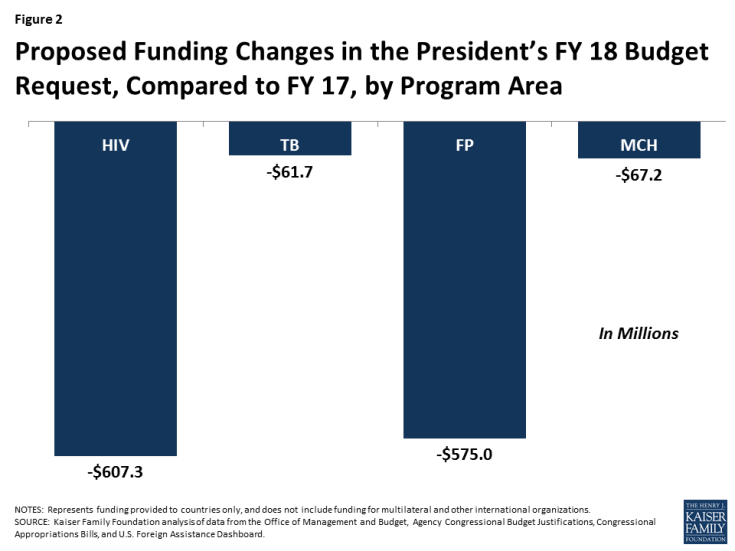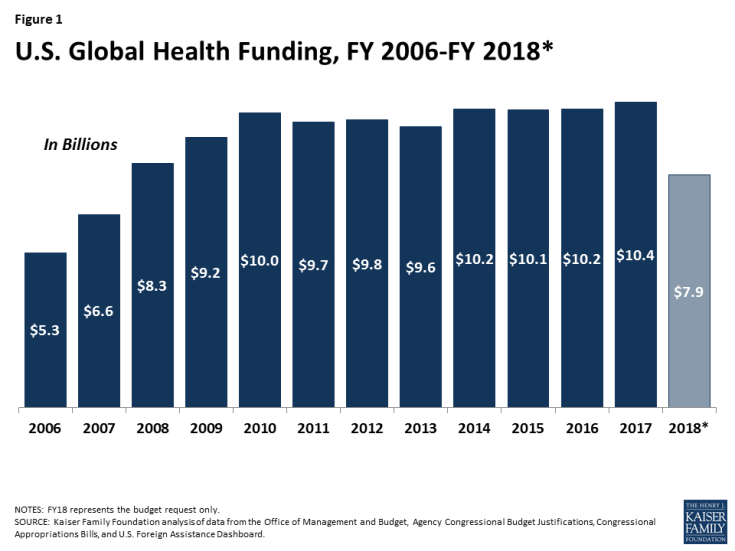What Could U.S. Budget Cuts Mean for Global Health?
Key Points
- President Trump’s FY 18 budget request to Congress includes unprecedented cuts to global health. If enacted, they would total approximately $2.5 billion and bring funding below FY 08 levels. Still, the President’s budget is just the first step in a longer process where Congress now takes center stage.
- We developed “budget impact models” to assess the impact of funding cuts. We modeled three budget scenarios – the Administration’s proposed cuts as well as two more modest decreases – in countries that receive U.S. global health assistance for HIV, TB, family planning, and maternal, newborn, and child health.
- Based on our models, the potential health impacts of these one-year cuts is significant across all three budget scenarios. For example, depending on the size of the cut, we estimate that starting next year:
- Additional new HIV infections would range from 49,100 to 198,700; the number of people on antiretrovirals could decline by more than 830,000 in the steepest budget cut scenario;
- Additional new TB cases would range from 7,600 to 31,100;
- The number of women and couples receiving contraceptives would decline, ranging from 6.2 million to almost 24 million; the increase in the number of abortions would range between 778,000 to almost 3 million; and
- Additional maternal, newborn, and child deaths would range between 7,000 and 31,300.
- While the fate of this year’s global health budget remains uncertain, these models illustrate the relationship between such decisions and health outcomes in low- and middle-income countries and provide one important tool for assessing future budget choices.
Introduction
President Trump’s FY 18 budget request to Congress includes significant cuts to global health. If enacted, these cuts would total approximately $2.5 billion compared to FY 17 (a 23% reduction), and bring funding below FY 2008 levels (see Figure 1). For some global health program areas, the cuts are particularly steep. For example, PEPFAR funding to countries is cut by more than $600 million in the request and all $575 million for bilateral family planning1 is eliminated (see Figure 2). Still, the President’s budget is just the first step in a longer process where Congress now takes center stage and already, many members of Congress have indicated that they do not support cuts of this magnitude.2 At the same time, the proposed cuts – which represent the Administration’s statement of its policy priorities and set the initial framework for budget discussions in the coming year – in an already difficult budget environment suggest that the road ahead may be difficult for U.S. global health programs and the people they serve.
As Congress begins considering the request, it is important to understand how different budget choices could affect the health of those served by U.S. efforts. To do so, we developed “budget impact models” to examine the relationship between funding levels in U.S.-supported countries and health outcomes. We looked at four program areas of U.S. support – HIV, TB, family planning, and maternal, newborn, and child health. For each, we ran three budget scenarios, including the Administration’s proposed cuts as well as two more modest decreases (see Tables 1-4). We include only bilateral funding provided to countries; funding for multilateral and other international organizations was not included in our assessment. To the extent that support for these organizations is also cut (as proposed for several in the budget request), this approach would understate the impact.

Figure 2: Proposed Funding Changes in the President’s FY 18 Budget Request, Compared to FY 17, by Program Area
Results
Our models show that any cuts to global health funding by the U.S. will affect health outcomes in low- and middle-income countries, though they range significantly by budget scenario. (see Tables 1-4). For example, depending on the size of the cut, our models estimates that starting next year:
- Additional new HIV infections would range from approximately 49,100 to 198,700; similarly, additional HIV deaths would range from 22,300 to 90,500, and the number of people on antiretrovirals could decline by more than 830,000 in the steepest budget cut scenario.
- Additional new TB cases would range from 7,600 to 31,100 and TB deaths would range from 1,700 to 6,800;
- Decreases in the number of women and couples receiving contraceptives would range from approximately 6.2 million to almost 24 million; the increase in the number of abortions (most of which are unsafe 3) would range between 778,000 to almost 3 million; and
- Additional maternal, newborn, and child deaths would range between 7,000 and 31,300.
These estimates are based on one-year budget cuts only; if funding levels remain at the new, reduced level in the subsequent year, the cumulative impact would be doubled.
It is important to note that, while based on the latest available data, these models are intended to be illustrative only. They rely on certain assumptions that may or may not bear out in reality. For example, they assume that a change in U.S. funding will not result in a change in funding decisions made by other donors or host governments. In addition, they assume that any change in funding in a given program area is distributed proportionally, according to current spending allocations by country and type of intervention. Still, they provide one way to gauge the magnitude and direction of different budget choices. While the fate of this year’s global health budget remains uncertain, these models illustrate the relationship between such decisions and the health of those in low- and middle-income countries and provide one important tool for assessing future budget choices.
| TABLE 1: BUDGET IMPACT: PEPFAR HIV | |||
| Funding Change Scenarios FY17-18 | |||
| Scenario 1: $150 Million cut |
Scenario 2: $300 Million cut |
Scenario 3: $607.3 Million cut (Administration Proposal) |
|
| HIV Infections | +49,100 | +98,200 | +198,700 |
| HIV-Related Deaths | +22,300 | +44,700 | +90,500 |
| People on ARVs | -207,000 | -414,000 | -838,000 |
| NOTES: All figures are rounded. Scenario 3 (the Administration’s proposal) is based on analysis of bilateral funding provided to countries only, and includes funding provided through the Global Health Programs account at State and USAID; funding provided to CDC, the Global Fund to Fight AIDS, Tuberculosis and Malaria, IAVI, microbicides, UNAIDS, and for technical assistance and oversight, was not included. SOURCE: Kaiser Family Foundation analysis. |
|||
| TABLE 2: BUDGET IMPACT: TB | |||
| Funding Change Scenarios FY17-18 | |||
| Scenario 1: $15 Million cut |
Scenario 2: $30 Million cut |
Scenario 3: $61.7 Million cut (Administration Proposal) |
|
| TB Cases | +7,600 | +15,100 | +31,100 |
| TB-Related Deaths | +1,700 | +3,300 | +6,800 |
| NOTES: All figures are rounded. Scenario 3 (the Administration’s proposal) is based on analysis of bilateral funding provided to countries only, and includes funding provided through the Global Health Programs and ESF accounts at USAID (ESF funding was estimated for FY17); funding provided to CDC, the TB Drug Facility and for MDR Financing was not included. SOURCE: Kaiser Family Foundation analysis. |
|||
| TABLE 3: BUDGET IMPACT: FAMILY PLANNING | |||
| Funding Change Scenarios FY17-18 | |||
| Scenario 1: $150 Million cut |
Scenario 2: $300 Million cut |
Scenario 3: $575 Million cut (Administration Proposal) |
|
| Couples/Women Receiving Contraception | -6,218,200 | -12,436,500 | -23,836,600 |
| Unintended Pregnancies | +1,847,700 | +3,695,300 | +7,082,700 |
| Abortions | +777,500 | +1,555,100 | +2,980,500 |
| Maternal Deaths | +3,700 | +7,400 | +14,200 |
| NOTES: All figures are rounded. Scenario 3 (the Administration’s proposal) is based on analysis of bilateral funding provided to countries only, and includes funding provided through the Global Health Programs and ESF accounts at USAID. SOURCE: Guttmacher Institute, Just the Numbers: The Impact of U.S. International Family Planning Assistance, July 2017; Kaiser Family Foundation analysis. |
|||
| TABLE 4: BUDGET IMPACT: MATERNAL, NEWBORN, & CHILD HEALTH | |||
| Funding Change Scenarios FY17-18 | |||
| Scenario 1: $15 Million cut |
Scenario 2: $30 Million cut |
Scenario 3: $67.2 Million cut (Administration Proposal) |
|
| Maternal/Newborn/Child Deaths | +7,000 | +14,000 | +31,300 |
| NOTES: All figures are rounded. Scenario 3 (the Administration’s proposal) is based on analysis of bilateral funding provided to countries only, and includes funding provided through the Global Health Programs and ESF accounts at USAID (ESF funding was estimated for FY17); funding provided to GAVI and the Global Development Lab was not included. SOURCE: Kaiser Family Foundation analysis. |
|||

